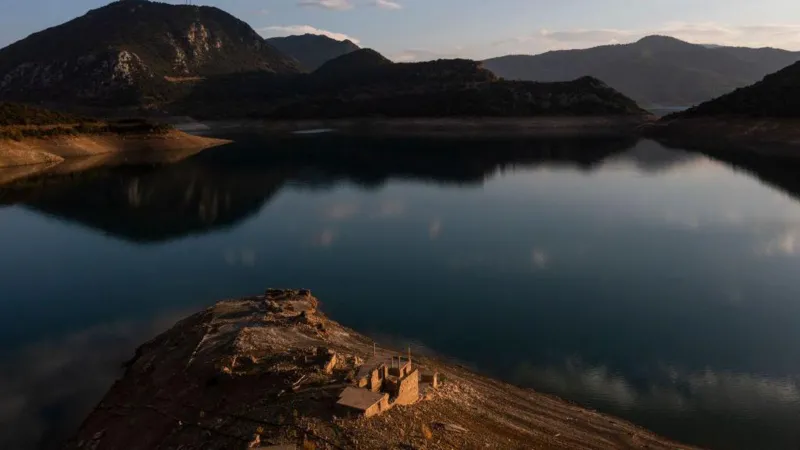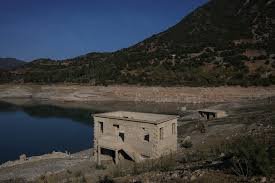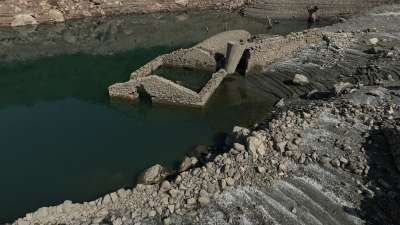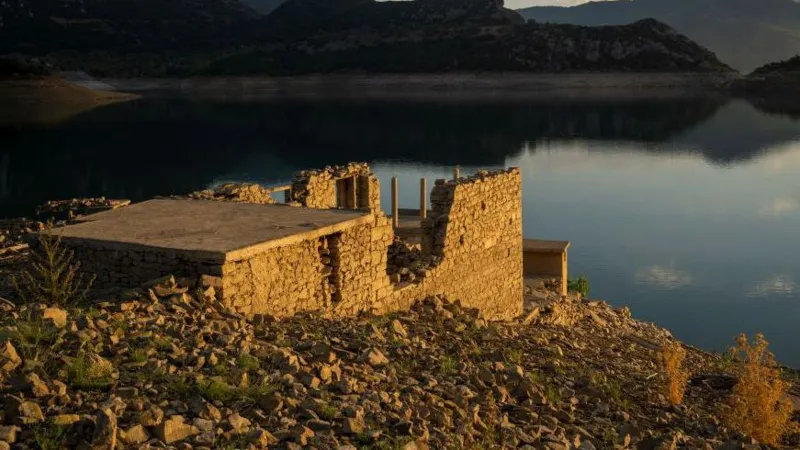In a remarkable turn of events, the ancient village of Kallio, located in southern Greece, has re-emerged from beneath the waters of the Mornos Reservoir, after more than 40 years of being submerged. The village, which was submerged to create a reservoir to supply water to Athens, has re-emerged thanks to severe drought conditions that have dramatically lowered the water level.
The Underwater Village
Kallio, a quaint Greek village that was once teeming with life, was lost to the depths of the Mornos Reservoir when its residents were relocated in the early 1980s. The construction of the Mornos Dam was a necessary step to meet the growing water demand of the Greek capital, Athens. In the process, the village – which includes around 80 houses, a church and a school – was sacrificed to create a massive reservoir that now plays a vital role in supplying water to the Attica region.

For more than four decades, the ruins of Kallio have been hidden beneath the waters of the reservoir, a silent witness to the passage of time. The only time it briefly surfaced was during a severe drought, providing a glimpse of the submerged village. However, it recently appeared amid an unprecedented drought that has hit Greece hard, exposing the village more widely than ever before.
A glimpse into the past
The recent drop in water levels has exposed many of Kallio’s key structures, including the remains of houses, a school and other buildings. Yorgos Iosifidis, a 60-year-old pensioner who spent his youth in Kallio, shared his emotional experience of seeing the remains of his old home. “You can see the first floor of my father-in-law’s two-story house… and next to it you can see what’s left of my cousin’s house,” Iosifidis told AFP. The discovery has triggered a mixture of nostalgia and sadness among former residents and their descendants. The village’s reappearance provides a rare and vivid connection to the past, allowing people to walk among the ruins and remember the time when their ancestors lived here. The sight of the submerged village is a reminder of the significant changes that have occurred over the decades, both in terms of the physical environment and the lives of displaced people.

The impact of drought
The re-emergence of Kallio is directly linked to Greece’s current severe drought conditions, which have led to an unprecedented drop in reservoir levels. The summer of 2024 has been one of the hottest on record for Greece, with June and July breaking temperature records. Water levels in the Mornos reservoir, a major source of water for Athens, have fallen by around 30%, raising concerns about future water shortages.
The drought has exposed not just Kallio, but the wider challenges Greece faces in managing its water resources. Water levels in other reservoirs supplying water to the Attica region have also dropped significantly, further exacerbating the water crisis. The reduced water availability has led Greek authorities to call for increased water conservation efforts and precautions against water waste.
Government response and public awareness
In response to the dwindling water supply, the Greek government has launched a number of initiatives aimed at raising public awareness and encouraging water conservation. Prime Minister Kyriakos Mitsotakis stressed the urgent need to protect water resources, saying, “We do not have the luxury of wasting water… at a time when we know for sure that we will have less water.” His comments reflect growing concern about the sustainability of Greece’s water resources amid changing climate conditions.
State water operator EYDAP has also issued a warning to the 3.7 million residents of the Attica region, urging them to save water and reduce usage. The call to action underscores the need for collective responsibility in addressing the water crisis and preparing for future challenges.

Historical and environmental significance
The reappearance of Kallio provides valuable insights in both historical and environmental terms. Historically, it provides a tangible link to a past era, allowing researchers and historians to study the impact of large-scale infrastructure projects on local communities. Environmentally, it is a stark reminder of the effects of climate change and the critical need for effective water management strategies.
The sight of a submerged village also raises questions about the long-term effects of such infrastructure projects on the local environment and communities. As Greece continues to experience increasingly frequent and severe droughts, Kallio’s situation highlights the importance of balancing development with environmental sustainability and community well-being.
